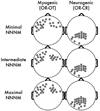Validation of ICA-based myogenic artifact correction for scalp and source-localized EEG
- PMID: 19833218
- PMCID: PMC2818255
- DOI: 10.1016/j.neuroimage.2009.10.010
Validation of ICA-based myogenic artifact correction for scalp and source-localized EEG
Abstract
Muscle electrical activity, or "electromyogenic" (EMG) artifact, poses a serious threat to the validity of electroencephalography (EEG) investigations in the frequency domain. EMG is sensitive to a variety of psychological processes and can mask genuine effects or masquerade as legitimate neurogenic effects across the scalp in frequencies at least as low as the alpha band (8-13 Hz). Although several techniques for correcting myogenic activity have been described, most are subjected to only limited validation attempts. Attempts to gauge the impact of EMG correction on intracerebral source models (source "localization" analyses) are rarer still. Accordingly, we assessed the sensitivity and specificity of one prominent correction tool, independent component analysis (ICA), on the scalp and in the source-space using high-resolution EEG. Data were collected from 17 participants while neurogenic and myogenic activity was independently varied. Several protocols for classifying and discarding components classified as myogenic and non-myogenic artifact (e.g., ocular) were systematically assessed, leading to the exclusion of one-third to as much as three-quarters of the variance in the EEG. Some, but not all, of these protocols showed adequate performance on the scalp. Indeed, performance was superior to previously validated regression-based techniques. Nevertheless, ICA-based EMG correction exhibited low validity in the intracerebral source-space, likely owing to incomplete separation of neurogenic from myogenic sources. Taken with prior work, this indicates that EMG artifact can substantially distort estimates of intracerebral spectral activity. Neither regression- nor ICA-based EMG correction techniques provide complete safeguards against such distortions. In light of these results, several practical suggestions and recommendations are made for intelligently using ICA to minimize EMG and other common artifacts.
Copyright (c) 2009 Elsevier Inc. All rights reserved.
Figures










Comment in
-
ICA-based muscle artefact correction of EEG data: what is muscle and what is brain? Comment on McMenamin et al.Neuroimage. 2011 Jan 1;54(1):1-3; discussion 4-9. doi: 10.1016/j.neuroimage.2010.04.256. Epub 2010 May 2. Neuroimage. 2011. PMID: 20441799
References
-
- Allen JJB, Coan JA, Nazarian M. Issues and assumptions on the road from raw signals to metrics of frontal EEG asymmetry in emotion. Biological Psychology. 2004;67:183–218. - PubMed
-
- Anemuller J, Sejnowski TJ, Makeig S. Reliable measurement of cortical flow patterns using complex independent component analysis of electroencephalographic signals. Lecture Notes in Computer Science. 2004;3195:1009–1016.
-
- Beckmann CF, Smith SM. Probabilistic independent component analysis for functional magnetic resonance imaging. IEEE Transactions on Medical Imaging. 2004;23:137–152. - PubMed
-
- Bell AJ, Sejnowski TJ. An information-maximization approach to blind separation and blind deconvolution. Neural Computation. 1995;7:1004–1034. - PubMed
Publication types
MeSH terms
Grants and funding
LinkOut - more resources
Full Text Sources
Miscellaneous

